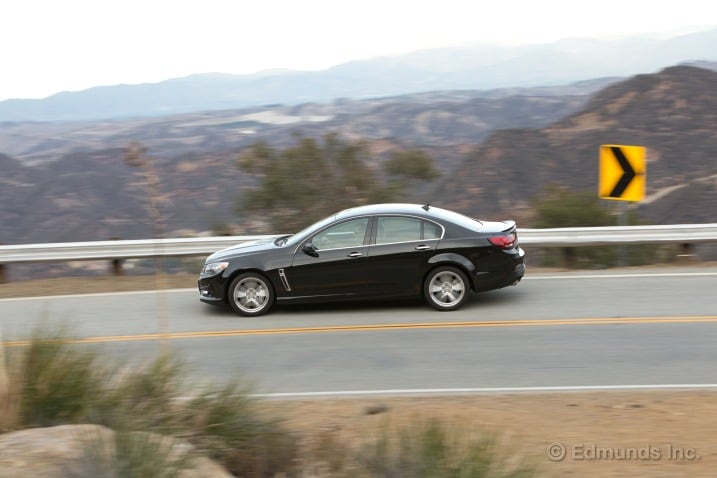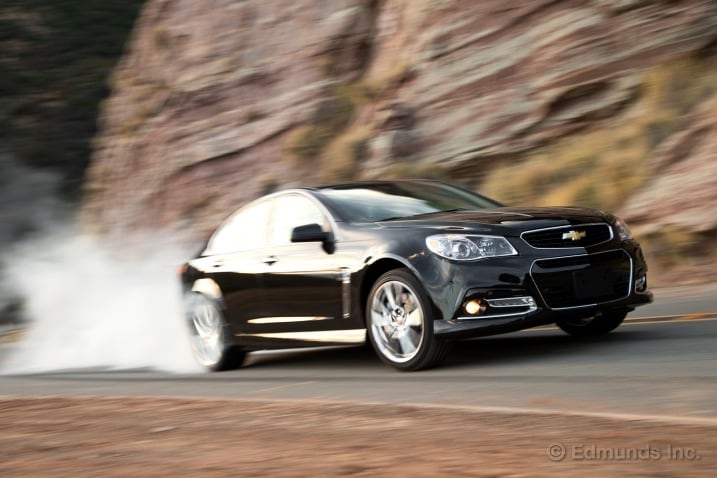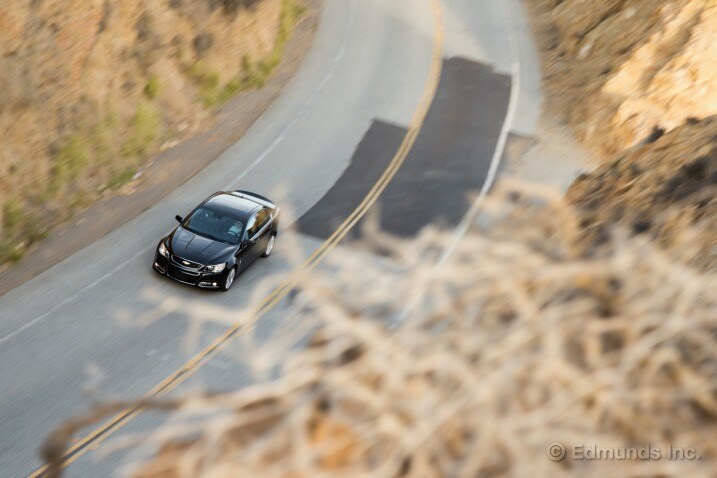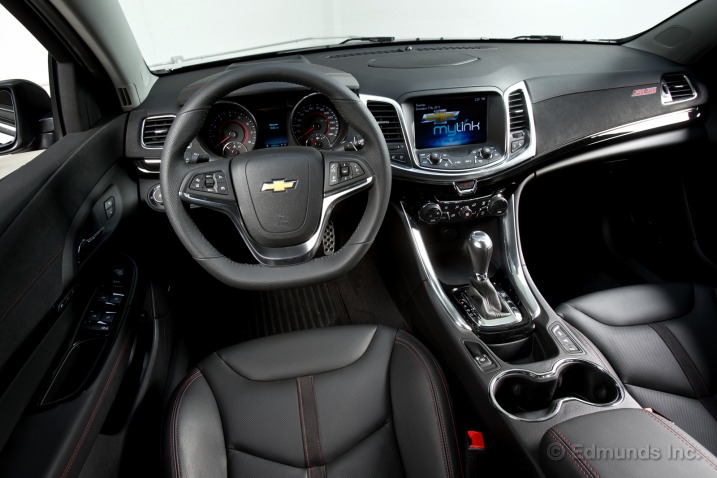The Half-Price M5 Returns. As a Chevrolet.
The SS’s styling isn’t full of flourish but it is clean and mean.
Published: 12/19/2013 - by Josh Jacquot, Senior Editor
America, it seems, remains bent on ignoring some truly good stuff. Stuff like wagons, diesels and Parker Posey, not to mention big, fast sedans like the new 2014 Chevrolet Super Sport (SS).
This is, after all, the sort of car that built this country. Heck, it’s the car that built Chevrolet. So there’s some irony in the fact that the Chevrolet SS is from Australia, not to mention that it’s called the Holden VF Commodore in that country.
But there’s no irony in the fact that the Chevy SS is a for-real driver’s car and a genuine people hauler. After all, it’s a Pontiac G8 underneath the skin, which was a fun and respected machine. But you may already know that. What you don’t know is how it drives, how it rides and whether it’s worth the asking price. We’re here to tell you it does all of the above better than you might think.
Will Hold Its Own Against the BMW M5
The acceleration impresses, but the SS really shines on these types of roads.
With 48 percent of its mass on the rear axle, the SS has physics on its side when it comes to spreading out the load of hard driving. Also aiding that task are standard 19-inch Bridgestone Potenza RE050A tires: 245/40 up front and 275/35 out back. Along with the balanced chassis, these meats aid the SS in a 0.92g circumnavigation of our skid pad, making it marginally less grippy than the wildly more costly 2014 Cadillac CTS Vsport sedan.
The SS confidently slipped through our 600-foot slalom at 68.8 mph while exhibiting a level of control more often demonstrated by cars lighter than the SS’s 4,016 pounds. Also consider that both of these handling numbers are virtually identical to those of the last BMW M5 we tested.
Electrically assisted steering is used, but it hasn’t dulled this sedan’s responses compared to more traditional hydraulic setups. In fact, one of the SS’s biggest strengths is steering so well endowed with feedback that we’d confidently toss the big sedan into a powerslide with our mother-in-law in the passenger seat.
A Little Bit of Corvette Under the Hood
The LS3 makes it easy, even in higher gears.
GM’s proven LS3 V8 powers the 2014 Chevrolet SS. It was used in the last-generation Corvette and in this application it’s rated to produce 415 horsepower and 415 pound-feet of torque. A standard 6L80 six-speed automatic transmission snaps off downshifts with aggressive rev matching actuated by wheel-mounted paddles. Power hits the ground through a clutch-type limited-slip differential, which also comes as standard equipment.
It’s no next gen LT1 but the use of the older engine became less of a downer after the SS ripped off a 13.2-second quarter-mile at 107.4 mph at our test track. In the process it hit 60 mph in 4.9 seconds (4.7 seconds with a 1-foot rollout like at a drag strip). That’s a fast car, new V8 or not.
It has no trouble slowing down either. Four-piston Brembo calipers coupled with 14-inch front rotors combine to consistently haul the SS down from 60 mph in 110 feet with no fade.
All that and the engine still managed to match the EPA’s combined fuel economy rating of 17 mpg (14 city/21 highway) after 475 miles of driving.
A Firm Ride That You Will Like
Tuned for there, not here.
But it’s not the powertrain that validates the Chevy SS to enthusiasts and family haulers alike. Rather, it’s the chassis — MacPherson struts up front and a multilink arrangement in the rear — that deserves attention. Sure, these are essentially the same hard parts that have been around for the better part of the last decade in various Australian models that have been sold here before. But in this application they’ve been tuned specifically for hard-charging-sedan-loving Aussies.
Wait, what?
Sure, there might have been some development work done on the SS in the U.S., but this doesn’t feel like a sedan tuned for American roads. The SS feels like it’s built for shaking off pricey German hangers-on in one quick shot of back-road glory. From behind the wheel, where it matters, the SS is clearly dedicated to just that task.
There’s solidity to every response that was, for years, the sole domain of the Germans. Now, however, taut dampers and an unyielding structure are the realm of this performance sedan, a change that makes the SS’s ride a little busier than an equally capable German sedan.
Manson stands by the SS’s static suspension tuning, calling it a “solid compromise,” but he’s not shy in pointing out that GM’s Magnetic Selective ride control can be adapted to the SS. He says the car’s primary benchmark was the Dodge Charger SRT8, which comes with two-mode active dampers but even so lacks a compliant ride and can’t match the SS’s sophisticated feel or handling numbers.
The G8 That’s Not a G8
New look, same great taste.
If you remember the Pontiac G8 you’ll likely recognize the SS despite its different look and feel. The revisions are vast enough that Manson discounts comparisons to the former car sold in the U.S.
“People like to think because the SS shares hard parts with previous cars that it’s the same,” says Manson. “But so much is different. We’ve got an aluminum hood and trunk lid that save 22.1 pounds over the old Commodore, and we save another 27 pounds using high-grade steel in critical areas.”
The result of that latter change is a 5-6 percent gain in torsional rigidity. In non-engineering-speak, that means the chassis flexes less, which contributes to the more precise handling.
Spacious, High-Quality Interior
The SS’s interior is on a different level than the Pontiac G8. It’s easily competitive with cars priced in the upper-$40,000 range.
Possibly the most easily appreciated differences are inside the 2014 Chevrolet SS. The interior is an incredible leap forward. Leather-wrapped trim covers the dash and door panels. The heavily bolstered leather seats offer suede detailing, and a proprietary thick-rimmed steering wheel adds a sense of purpose. There’s an 8-inch touchscreen display for navigation, audio and other functions, plus two knobs to manage dual-zone climate control. Everything looks and feels great.
Possibly the only interior component of the G8 that remains was its biggest strength: ample rear-seat room. Whether you plan to haul full-size adults or install child seats you’ll find enough space to accommodate your needs. Rear access, thanks to wide door openings, doesn’t hurt, and neither does a massive 16.4-cubic-foot trunk.
Front collision and lane departure warning systems as well as Automatic Parking assist — which manages steering during parallel parking maneuvers — are standard equipment on the SS. Only two options are available: a $900 sunroof and a $500 full-size spare tire.
A Smoking Deal
Get it while it lasts.
In probably the least fortunate car-launch timing in history, GM announced — just as SS sedans rolled onto dealer lots this month — that it plans to close Holden’s Elizabeth, South Australia, plant that builds the Chevy SS in 2017.
Does this mean the end of the SS before it’s even had a chance to get started? We have no idea. After driving the 2014 Chevy SS we sure hope it finds a way to stick around. With a starting price of $44,470, the SS is a solid value among large performance sedans. Our test car fitted with both options, and including the $1,300 gas-guzzler tax, totaled $47,170.
That’s no small price for a Chevrolet sedan, but compare its capabilities to the competition and the value is clear. At that price, America’s wholesale rejection of good stuff (especially the V8-powered rear-drive sedan) looks even sillier.

















.png)



